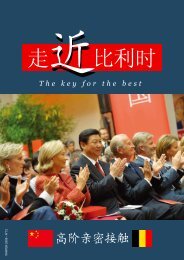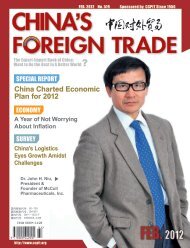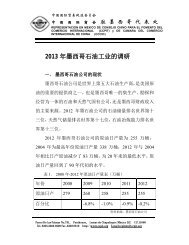F REIGN TRADE - 中国国际贸易促进委员会
F REIGN TRADE - 中国国际贸易促进委员会
F REIGN TRADE - 中国国际贸易促进委员会
Create successful ePaper yourself
Turn your PDF publications into a flip-book with our unique Google optimized e-Paper software.
of the respondents are satisfied withdomestic sales growth, 50.2% satisfiedwith domestic market share growth and44.5% satisfied with the profit growthrate of domestic sales.See Figure 2.3According to a comparison of thedegree of satisfaction with domesticbusiness development between privateenterprises and state-owned enterprisesillustrated in Figure 2.4, private enterprisesshow less satisfaction than stateownedenterprises in six aspects, namelydomestic sales, domestic sales growth,domestic market share, domestic marketshare growth, domestic profitability andprofit growth rate of domestic sales.See Figure 2.4In a conclusion, first, the enterprisesgoing global generally feel goodabout domestic business development,but nearly half of the enterprises are notso satisfied with various indicators ofdomestic business. This serves as a majorforce that drives them to go global.Secondly, private enterprises are obviouslyless satisfied with domestic businesswhen compared with state-ownedenterprises, showing that private enterprisesface more severe restrictions andcompetition in the domestic market. Itcan be said that the going global moveby private enterprises to some extent aremotivated by the pressure of developmentat home.Purposes of going global1. Chinese enterprises engage in overseasinvestment to expand market expansionrather than acquire resourcesEnterprises conduct outward directinvestment to optimize the allocationof resources worldwide and expandmarkets both at home and abroad.Chinese enterprises with potential inoverseas investment mainly includethree types: i) State-owned energy andresources enterprises, which the aim tostabilize domestic resource supply andbenefit from rising prices of raw materialsby mobilizing upstream resources; ii)High-tech enterprises, mainly includingthose in communications and ITindustries, which hope to participate inglobal competition and gain technologicalresources; iii) Enterprises with comparativeadvantages, mainly includingtextiles, clothes and home appliancesRising rates of production costsHigh degree of competition in the domesticmarketGreat difficulty to obtain high-levelpersonnel within the industryHigh degree of perfection of upstreamand downstream industriesGreat difficulty of financing fromthe domestic marketGreat domestic market growth potentialGreat difficulty to obtain the technologythat product innovation requiredHigh degree of government regulationGreat competitive pressure from foreignmultinational corporationsGreat access restrictions of the industryGreat difficulty of domestic accessto parts and raw materialsFigure 2.1 Evaluation of the enterprises going globalregarding their domestic development prospectsFigure 2.2 Evaluation of state-owned enterprises and privateenterprises regarding domestic development prospects38.9%46.1%45.9%51.0%65.6%63.6%61.7%59.1%58.8%73.1%76.8%30% 35% 40% 45% 50% 55% 60% 65% 70% 75% 80%High degree of competitionin the domestic market69.6%85.7%High degree of perfection of upstream73.1%and downstream industries58.1%Rising rates of production costsGreat difficulty to obtain high-levelpersonnel within the industry73.1%74.6%67.2%63.3%Great difficulty to obtain the technology64.2%that product innovation required56.4%Great domestic market growth potential62.9%56.9%High degree of government regulation55.9%53.0%Great access restrictions of the industry43.8%53.7%Great competitive pressure from50.7%foreign multinational corporations44.2%Great difficulty of financing48.5%from the domestic market66.1%33.8%Great difficulty of domestic access41.1%to parts and raw materials30% 40% 50% 60% 70% 80% 90%State-owned firmsPrivate firmsenterprises, which desire to penetrateinternational markets and circumventtrade restrictions. Investment motivesof the said three types of enterprises canbe further broken down into two types:overseas market-seeking and resourceseekingmotives.According to responses to surveyquestions measuring the importance ofvarious functions offered by overseasbranches of outward-investing enterprises,the most important functionsserved by these branches are aimed atcreating new market opportunities, includingmanufacturing and promotingproducts for parent companies (66.1%),providing after-sales services to parentcompanies (57.6%), improving thereputation of parents in host countries(54.2%), obtaining internationallyfamous brands (45.2%) and avoidingbarriers in major destinations of export(40%). Functions reflecting the motiveto obtain overseas resources, suchas obtaining parts or raw materials forparent companies (38.1%), manufacturingproducts of parent companiesbased on local cost advantages (35.8%),25

















